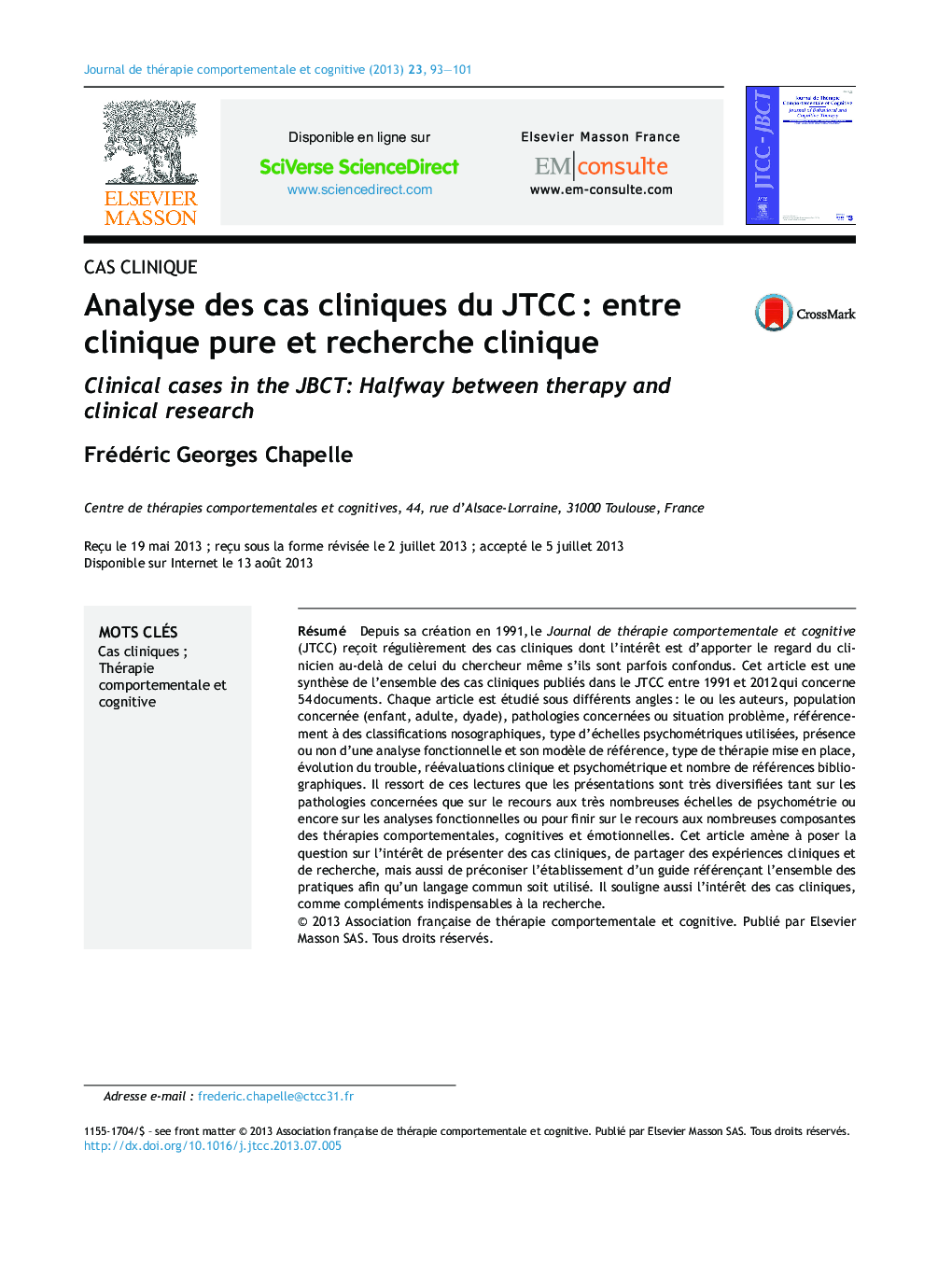| کد مقاله | کد نشریه | سال انتشار | مقاله انگلیسی | نسخه تمام متن |
|---|---|---|---|---|
| 934632 | 923677 | 2013 | 9 صفحه PDF | دانلود رایگان |
عنوان انگلیسی مقاله ISI
Analyse des cas cliniques du JTCCÂ : entre clinique pure et recherche clinique
دانلود مقاله + سفارش ترجمه
دانلود مقاله ISI انگلیسی
رایگان برای ایرانیان
کلمات کلیدی
موضوعات مرتبط
علوم پزشکی و سلامت
پزشکی و دندانپزشکی
روانپزشکی و بهداشت روانی
پیش نمایش صفحه اول مقاله

چکیده انگلیسی
The presentation of clinical case studies is a rich and long history in both psychology and medicine. Regardless of therapeutic orientation, numerous authors have published clinical case studies over the last century. Clinical case studies (CCS) can be regarded in two ways: as the subjective narrative of an interesting case or as a means to incite progress in research. CCS have been regarded in the last 30 years as “unscientific” and too subjective to be of use for the scientific community; as a result publication of such cases has decreased in the recent years. Yet as many authors have pointed out, CCS have utility for both clinicians and researchers (Hanley, 2012 [4]; Callahan, 2012 [66]; Barker et al., 2002 [68]; Dattilio et al., 2010 [69]). The presentation of a CCS is usually made “after the fact”, i.e. after a patient has entered into a therapeutic alliance and the practitioner has determined that this case could be of interest to colleagues in the clinical and scientific community. CCS require careful conceptualization and writing in order to preserve the interesting aspects of the case, guarantee patient anonymity, and provide adequate data and information for the reader to gain a better understanding of the explored pathology. While CCS have been regarded as dubious contributions, Hanley cogently presents the arguments for and against the publication of case studies; the author concludes that it is in the best interest of practitioners and scientists to continue to publish CCS in the coming years. The current article reviews all of the CCS that have been published in the JBCT over the previous 22 years and attempts to understand the different objectives of these published CCS as well as provide encouragement for publication of CCS in the future. Fifty-four CCS have been published in the JBCT since its introduction in 1991. Of these, one was presented as an editorial (Rusinek, 2012 [5]) and another as an analysis of a famous person (Guillerm, 2002 [6]); the remainder presented cases encountered by practitioners of cognitive behavioral therapy (CBT). The majority of cases were from French practitioners, with a small number from Swiss, Canadian, and Moroccan authors. One article was published by an American author. Most of the cases concerned adults (72%) with the remainder focusing on children and one article on a mother-infant dyad. A wide variety of diagnostic categories was represented in the sample in decreasing order: panic disorder with agoraphobia (4 articles); alcoholism, ADHD, PTSD, OCD, and psychosis (3 articles each); and two articles each for hypochondria, autism, social anxiety, GAD, specific phobias, and separation anxiety. The remaining half of the published CCS focused on complicated and unique pathologies (e.g., eating disorder NOS, kleptomania, trichotillomania, etc.). For nearly one half of the articles, no presenting diagnostic classification (DSM or CIM) was provided. Over one half the CCS provided data regarding psychological tests and/or a functional analysis of the presenting problem. As for treatment modalities, 35 CCS were clearly treated with cognitive therapy and 33 with behavioral therapy. Many cases presented focused on specific aspects of therapy without providing full therapeutic details; for example the utility of psycho-education or relaxation strategies. Most of the CCS provided follow-up data as well as information regarding patient evolution. The wide variety of CCS, along with the fact that the majority did not provide nosographic data pleads in favor of continuing, and encouraging the practice of publishing CCS, particularly in the JBCT. While diagnostic criteria are useful, it is of particular importance to note the phenomenological aspects of these cases and what they can provide to practitioners who may face similar patients as well as what they can incite researchers to focus on in future studies. It is hoped that the JBCT will provide not only a more clearly-defined framework for the future publication of CCS but incite clinicians to share their precious experiences with both the clinical and scientific CBT community in francophone countries.
ناشر
Database: Elsevier - ScienceDirect (ساینس دایرکت)
Journal: Journal de Thérapie Comportementale et Cognitive - Volume 23, Issue 3, September 2013, Pages 93-101
Journal: Journal de Thérapie Comportementale et Cognitive - Volume 23, Issue 3, September 2013, Pages 93-101
نویسندگان
Frédéric Georges Chapelle,